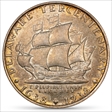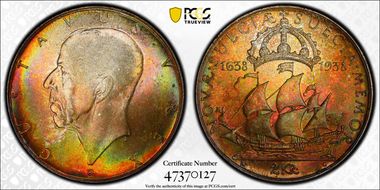The Brandywine Collection 的展示图片库
Stunning color on a this Swedish 2 Kronor celebrating the 300th Anniversary of the landing of the Swedes & Finns in Delaware. Featuring the Kalmar Nyckel and King Gustaf V. The Latin inscription on the reverse (the side with the ship), “NOVÆ SUECIÆ SUECIA MEMOR”, translates as “Sweden Remembers New Sweden”. Latin hadn’t appeared on a Swedish coin since the time of Gustav III in the late 18th century. The years 1638 and 1938 are featured on either side of the ship, a nod to the tercentenary. The ‘G’ privy mark below the ship’s stern stands for mint master Alf Gerhard Grabe. Below the bow, the St. Erik mintmark indicates the coin was minted in Stockholm. Above the Kalmar Nyckel is a depiction of the royal crown. Erik Lindberg’s Kalmar Nyckel is more angular and svelte than Carl Schmitz’s design. It’s a model of efficiency to get settlers to their destination safely and quickly. Sweden’s King Gustav V, who attended the 1938 celebration in Delaware, is featured on the obverse. Around the King’s portrait is “GUSTAVUS V REX”, Latin for “King Gustaf V.” Below the neckline of the King’s portrait are the designer’s initials, EL (Erik Lindberg).
This was the first coin of the US Mint’s new 50 State Quarters Series, released on Jan. 4, 1999. The legislation that authorized the state quarter program in 1997 was introduced by Delaware Representative Mike Castle. Each state’s governor was responsible for submitting concepts to the mint, but they had leeway on how they came to those selections. Delaware’s Governor asked residents to submit ideas to the Delaware Arts Council for review. Once the US Mint finalized three potential designs for the reverse, Delawareans were asked to vote on their favorites. Of the 1,519 votes cast, the Caesar Rodney reverse, engraved by William Cousins and based on artist Eddy Seger’s submission, received 948. Both the final design and the original submission were based on James Edward Kelly’s sculpture of Caesar Rodney that stood in Wilmington’s Rodney Square between 1923 until 2020. Mr. Seger taught at art at Caesar Rodney High School in Camden, DE at the time. When he learned that Delawareans were being asked to submit ideas for the new coin, he made it an art project. Of the 340 submissions to the Arts Council, 39 came from his students. The ceremonial first strike of the new series took place at the Philadelphia Mint on Dec. 7, 1998, the anniversary of the state’s ratification of the Constitution.
This was the first coin of the US Mint’s new 50 State Quarters Series, released on Jan. 4, 1999. The legislation that authorized the state quarter program in 1997 was introduced by Delaware Representative Mike Castle. Each state’s governor was responsible for submitting concepts to the mint, but they had leeway on how they came to those selections. Delaware’s Governor asked residents to submit ideas to the Delaware Arts Council for review. Once the US Mint finalized three potential designs for the reverse, Delawareans were asked to vote on their favorites. Of the 1,519 votes cast, the Caesar Rodney reverse, engraved by William Cousins and based on artist Eddy Seger’s submission, received 948. Both the final design and the original submission were based on James Edward Kelly’s sculpture of Caesar Rodney that stood in Wilmington’s Rodney Square between 1923 until 2020. Mr. Seger taught at art at Caesar Rodney High School in Camden, DE at the time. When he learned that Delawareans were being asked to submit ideas for the new coin, he made it an art project. Of the 340 submissions to the Arts Council, 39 came from his students. The ceremonial first strike of the new series took place at the Philadelphia Mint on Dec. 7, 1998, the anniversary of the state’s ratification of the Constitution.
The America the Beautiful Quarters program, introduced in 2010, depicted national parks or sites through 2021. Five designs were released each year in the order that the parks were established. The decision to feature Bombay Hook was made in 2010, five years before the quarters were issued. The Bombay Hook National Wildlife Refuge, one of the largest tidal salt marshes in the mid-Atlantic, was established in 1937. It received its name from the Dutch phrase "Boompjes Hoeck”, which sounds like Bombay Hook, meaning "little-tree point. A Blue Heron and a Great Egret are featured on the reverse, which are common birds in the summer. It was designed by Joel Iskowitz and sculpted by Phebe Hemphill.
The America the Beautiful Quarters program, introduced in 2010, depicted national parks or sites through 2021. Five designs were released each year in the order that the parks were established. The decision to feature Bombay Hook was made in 2010, five years before the quarters were issued. The Bombay Hook National Wildlife Refuge, one of the largest tidal salt marshes in the mid-Atlantic, was established in 1937. It received its name from the Dutch phrase "Boompjes Hoeck”, which sounds like Bombay Hook, meaning "little-tree point. A Blue Heron and a Great Egret are featured on the reverse, which are common birds in the summer. It was designed by Joel Iskowitz and sculpted by Phebe Hemphill.






































